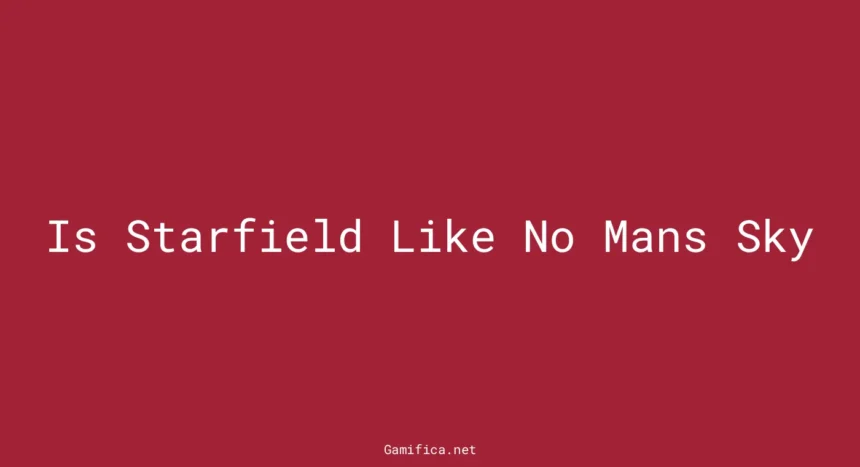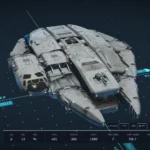Are you ready to embark on an intergalactic adventure that will leave you mesmerized? Well, get ready to explore the vastness of space as we dive into the captivating world of Starfield and No Man’s Sky. In this blog post, we will compare and contrast these two epic space games to determine if Starfield is truly like No Man’s Sky, or if it brings something entirely unique to the table. So strap in, because we’re about to take off on a cosmic journey filled with drama, excitement, and a whole lot of interstellar fun!
Understanding the Space Game Genre: Starfield vs No Man’s Sky
The allure of the cosmos has long beckoned players to the space game genre, where they can indulge in the fantasies of interstellar travel and extraterrestrial discovery. Among the stars of this genre, Starfield and No Man’s Sky shine with distinct brightness, offering unique interpretations of space exploration that cater to diverse gaming appetites.
Starfield: A Post-Star Wars Drama
Starfield emerges as a narrative-driven odyssey, a space opera that echoes the grandeur of the post-Star Wars era. It presents a tapestry of human-centric stories, woven into the fabric of high-stakes conflict and intergalactic intrigue. This title, crafted by the storied developers at Bethesda Game Studios, prioritizes a methodical, story-rich experience over the boundless sandbox of space.
While Starfield’s universe may yield its secrets to those who traverse its stars, it maintains a deliberate focus on depth over breadth. Here, players find themselves immersed in a cosmic adventure punctuated by meticulously designed quests and shootouts that would make any space marshal proud. The game’s architecture is built on the foundation of a carefully constructed narrative, ensuring that every planet explored and every alien encountered adds a meaningful chapter to the player’s journey.
| Feature | Starfield | No Man’s Sky |
|---|---|---|
| Genre | Space RPG | Space Sandbox |
| Focus | Storytelling, Quests | Exploration, Procedural Generation |
| Universe | Structured, Detailed | Vast, Infinite |
| Gameplay | Narrative-Driven | Open-Ended |
| Release Date | TBA | August 2016 |
In contrast to its contemporary, No Man’s Sky by Hello Games, which sprawls across an almost unfathomable number of procedurally generated planets, Starfield is a testament to crafted storytelling within a sci-fi universe. It’s a game that doesn’t just offer a spaceship and a galaxy to explore but also a reason to care about every leap through hyperspace and every landing on an alien terrain.
As players of Starfield strap into the pilot’s seat, they should expect not just a journey through space, but a voyage through a complex narrative, one that promises to challenge their moral compass as much as their spacefaring skills. Bethesda’s promise of an RPG set among the stars holds the potential for a game that’s as much about the characters and plot twists as it is about exploring new worlds.
Indeed, Starfield and No Man’s Sky may share the vast emptiness of space as their playground, but the paths they carve across the celestial sphere are as divergent as they are fascinating. One offers a journey scripted by the architects of epic tales; the other, a canvas for the wanderlust of the player’s own making. In the former, every star tells a story; in the latter, every planet is a blank page.
The space game genre is broad and ever-expanding, with each title offering its own unique constellation of features to navigate. Players drawn to the allure of a cinematic space epic will find a kindred spirit in Starfield, while those yearning for the freedom to forge their own interstellar path may find their home among the stars in No Man’s Sky.
No Man’s Sky: An Open-World Universe
When we delve into the cosmos of No Man’s Sky, we’re greeted with an expansive open-world universe that is nothing short of astronomical. With a mind-boggling 18 quintillion planets to explore, each with its own unique ecosystem and wildlife, the game stands as a testament to the vastness of the virtual cosmos. This sheer volume of celestial bodies dwarfs the number of star systems in Starfield, offering a strikingly different gameplay experience—one that champions exploration and discovery over a structured narrative.
Unlike the curated adventures of Starfield, No Man’s Sky is akin to an uncharted ocean, teeming with opportunities for pioneering exploration. Players are granted the freedom to carve their own path, whether it be through mining rare materials, engaging in interstellar trade, or simply wandering the varied landscapes that span across countless galaxies.
It’s important to note that while the size of No Man’s Sky’s universe is staggering, it isn’t the only factor that defines the game’s appeal. The procedural generation of planets ensures that no two gamers will have the same experience, making every journey a unique tale of space exploration. It’s this promise of a personalized odyssey that keeps players returning to the stars, eager to uncover the next undiscovered world or exotic species.
When discussing comparison with other games, it’s clear that No Man’s Sky shares a kinship with Starfield in its aspiration to immerse players in a vast, science-fiction environment. Yet, it also resonates with the likes of Assassin’s Creed Valhalla, Cyberpunk 2077, and Marvel’s Guardians of the Galaxy, which offer their own sprawling worlds ripe for exploration. However, No Man’s Sky sets itself apart by focusing on a player-driven narrative, where the story unfolds through the lens of individual experience rather than a pre-written script.
The Mod Factor: Seamless Space Travel
The allure of the unknown is a powerful force in both Starfield and No Man’s Sky. They converge on the concept of seamless space travel, a feature that captures the essence of science fiction’s boundless possibilities. A mod for Starfield ingeniously bridges the gap between the two, allowing players to transition from celestial body to celestial body without loading screens, akin to the seamless exploration found in No Man’s Sky. This mod is a nod to the community’s ingenuity and the shared vision of an uninterrupted space odyssey.
Yet, it’s crucial to recognize that the integration of this mod into Starfield’s gameplay doesn’t diminish the game’s originality. It simply enhances the exploration aspect, allowing spacefarers to indulge in the tranquility of the cosmos without disruption. This adaptation underscores the dynamic nature of the gaming industry, where developers and modders alike draw inspiration from one another, contributing to a richer, more diversified gaming landscape.
Starfield’s commitment to a well-crafted narrative and No Man’s Sky’s dedication to an open-world experience demonstrate the versatility of the space genre. Each game presents an interstellar canvas, inviting players to leave their footprints on alien soil and etch their stories among the stars.
Starfield: A Space RPG with a Difference
Embarking on an interstellar journey, Starfield shapes its identity as a space RPG, diverging significantly from the exploratory canvas of No Man’s Sky. Starfield, developed by Bethesda Game Studios, invites players into a meticulously crafted cosmos, featuring four major cities—each a hub of activity with its own unique pulse and storyline. New Atlantis, the cosmopolitan heart, stands as a testament to human ingenuity. Akila houses a diverse population united under the banner of freedom. The neon-soaked Neon offers a dive into hedonism and intrigue, while The Key remains shrouded in mystery, beckoning the curious and the brave.
These urban centers are more than just backdrops; they are narrative powerhouses providing the scaffolding for Starfield’s rich lore. The game’s storyline weaves through these cities, offering players a tapestry of quests and moral conundrums. This interplay of environment and narrative is what sets Starfield apart and resonates with RPG enthusiasts seeking a space opera with depth and direction.
No Man’s Sky: A Space Sandbox Game
Meanwhile, No Man’s Sky, developed by Hello Games, offers an alternative universe teeming with procedural wonders. It doesn’t confine players to a scripted odyssey but rather unleashes them into a sprawling sandbox galaxy. Here, the narrative is not written in stars but scribed by the adventurers themselves. In No Man’s Sky, every celestial body orbiting in the vastness of its universe promises an experience as unique as the player who discovers it.
The game’s ever-evolving nature ensures that exploration remains at the heart of the player’s journey. With an emphasis on survival, crafting, and building, No Man’s Sky engages those who yearn to carve out their own path and leave a personal imprint on the cosmos. It’s this boundless freedom and the allure of the unknown that distinguishes No Man’s Sky, making it a haven for explorers and creators alike.
Whether it’s the story-rich universe of Starfield or the open-ended galaxy of No Man’s Sky, space gaming aficionados have distinct worlds to satiate their cosmic appetites. Each game, in its own right, champions a unique aspect of the space genre, offering a stellar platform for escapism and adventure.
FAQ
Q: Why is Starfield so similar to No Man’s Sky?
A: Starfield and No Man’s Sky share similarities in their concept and gameplay features. Both games allow players to explore a vast interstellar map, discover planets, mine resources, build bases, and leave their own mark on the galaxy.
Q: Is Starfield better than No Man’s Sky?
A: Starfield and No Man’s Sky offer different strengths. Starfield focuses on storytelling and quests, providing an engaging RPG experience. On the other hand, No Man’s Sky excels in exploration, offering seamless and immersive gameplay with a vast number of planets and detailed ecosystems to discover. The preference between the two games depends on individual preferences and what aspects of gameplay are most important to the player.







